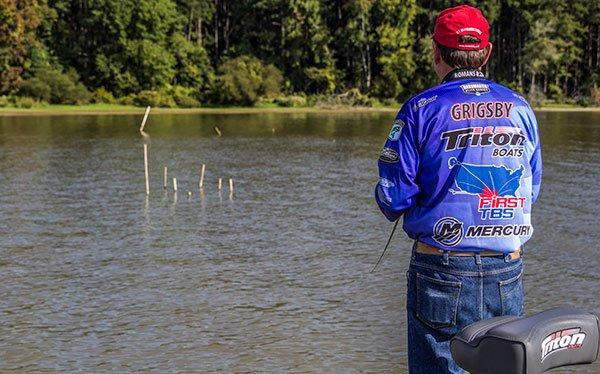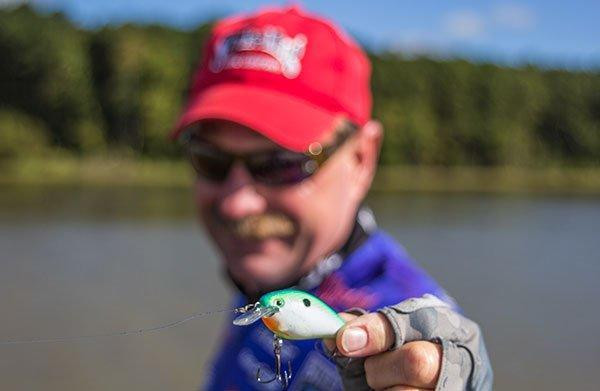As fall continues to progress, expect the bass to be gorging themselves on migrating shad in preparation for the winter. This means you need to be cranking shallow cover on your next trip to the lake.
Elite Series pro and television personality Shaw Grigsby has a hard time putting down his shallow crankbaits this time of year. Although many anglers are beginning to stray from shallow crankbaits as the water temperatures continue to cool, he believes there are 10 reasons to stick with it and capitalize on some of the year’s most fun fishing action.
1. Capitalize on ambush points
As you’re reading this article, there’s a high probability that there are shad littering the backs of your favorite fishery’s creeks. While you can enjoy moderate success with slower, more subtle presentations, Grigsby believes targeting key ambush points with shallow crankbaits is a surefire way to catch both quantity and quality.
“When the shad get onto the back flats of a creek, the bass chase them all over the place,” Grigsby said. “If the bass aren’t actively chasing bait, however, they’re going to hang around some type of cover. Not only does it give them with a sense of security from birds of prey, but it also provides them with an incredible ambush spot. They can hang back in the shadows and absolutely annihilate balls of shad when they pass by.”
According to Grigsby, a shallow squarebill crankbait is the best way to catch these opportunistic and paranoid creatures. When you locate a piece of shallow cover near a creek flat, he suggests making long casts past your target while keeping the crankbait low to the water. This deliberate approach will ensure you don’t spook any wary bass.
2. Effective on all types of cover
The allure of cranking shallow cover this time of year is simple—there are no golden rules or formulas that dictate the type of cover on which a bass will hold. If the cover is shallow and shad are nearby, it’s fair game.
Find the calm rocks: The warmest rocks can be found in calm water. As wind churns the water, it keeps the water temperature down, resulting in less active bass and fewer shad.
“It’s very important to let the fish tell you where they are,” Grigsby said. “When you’re cranking shallow cover, you don’t want to discriminate against anything to begin with. Fish everything you can and start banging that squarebill into anything you can reach. Make sure to pay close attention to your first couple of bites so you can develop a solid pattern.”
Grigsby admittedly favors wood in warmer water temperatures and will begin targeting rocks when the water temperatures reach the lower 50-degree range. Rocks conduct heat and retain it longer than other types of cover, which is advantageous for two reasons—the heat allows bass to regulate their body temperatures and also attracts more shad.
3. Works in all conditions
When many of us think about crankbait fishing, we envision windy, overcast days. Surprisingly, Grigsby is fairly indiscriminate when it comes to favorable shallow cranking conditions.
“I believe that fall bass will eat a crankbait regardless of the conditions,” Grigsby said. “Whether it’s high blue skies or cloudy and overcast, you can catch ’em. As long as you can bump the bottom and slam that crankbait into cover to give it an erratic action, you’re going to catch fish. The main thing you need to look for is something to run it into—if you’re in the strike zone and bumping into things, you’ll probably catch them. ”
Grigsby actually has some of his best days in calm conditions. When the water surface is flat, it makes it much easier to visually locate active shad. He keeps an eye out for any type of surface disturbance such as ripples, busting fish or small flickers. This activity is often indicative of active shad, which is a key ingredient of this technique.
4. Great for nasty cold fronts
Cranking shallow cover in the fall is most effective in the low-60 to mid-50-degree range, but that doesn’t mean it won’t work in colder temperatures. It’s totally possible to catch fish in 20-degree weather in just a few feet of water.
“Whenever you have your first serious cold front, shallow cranking can be absolutely amazing,” Grigsby said. “The sudden drop in temperature slows the shad down, flips them on their sides and even kills a lot of them. This is the ultimate dinner bell for bass—my gosh, do they eat! If you’re looking to have a bunch of fun, go crank shallow cover on that first really cold day because they’ll be chewing big-time.”
5. Match the hatch easily
Sticking with a “family” of crankbaits can prove extremely effective throughout the late fall. Each creek within a fishery can play host to different sizes of shad, so it’s important to have the ability to quickly change your crankbait size to match the profile of local forage.
Standard size: ”The 1.5 Strike King KVD HC Square Bill Silent Crankbait is my go-to crankbait when I’m targeting shallow cover,” Grigsby said. “It seems like the perfect size for most shad populations—it’s not too big and it’s not too small. More times than not, I’m going to start with this size.”
For small shad: “If you’re noticing a lot of smaller shad in the very backs of creeks, such as inch-long threadfin, a 1.0 Strike King KVD HC Square Bill Silent Crankbait is the way to go,” Grigsby said. “Even though it’s small, it’s super easy to throw on casting gear and has a very erratic action that drives them crazy.”
For larger forage: ”If I’m on a big bass factory such as Lake Guntersville or Kentucky Lake, I’m definitely going to spend some time throwing the larger 2.5 Strike King KVD HC Square Bill Silent Crankbait to try and catch some giants,” Grigsby said. “When you have a lot of big gizzard shad or herring swimming around, larger crankbaits can be outstanding in shallow water.”
6. Dissect cover quickly and efficiently
It doesn’t always take a Texas rig or a jig to thoroughly dissect cover. A big determining factor in your fall fishing success lies in your ability to cover water quickly. Shallow crankbaits give Grigsby that option.
It’s all about stealth: Grigsby suggests sneaking into shallow areas as quietly as possible. Using his Power-Poles, he’ll inch toward pieces of cover to avoid muddying the water with his trolling motor. The stealthier you can be, the more fish you’ll catch.
“Your first cast to a piece of cover needs to be close, but not in the middle of it,” Grigsby said. “I like to target the side or front initially so I can hook a bass and get them to the boat easily. After you saturate the outsides, start making casts to the middle and change your angles regularly.”
Repeated casts are a “must” when fishing shallow cover. As anglers, we only see the tip of the proverbial iceberg when looking at a piece of cover, so it’s important to saturate a piece of cover to target any key underwater irregularities. More than likely, there’s a lot more going on down there than meets the naked eye.
7. Any retrieve or cadence can work
Similar to the type of cover bass prefer in the fall, there isn’t a “set” retrieve that works better than others when cranking shallow cover. Irritating the bass is often the determining factor according to Grigsby.
“I primarily move the crankbait with my rod tip when I’m crawling it through thick cover,” Grigsby said. “I’ll sweep the rod, pick it up and pull a little bit to let the crankbait and its bill do their job. Sometimes the bass will want a slower retrieve through the cover and there will also be days when they want it burned by their faces. Either way, it’s important to ‘finesse’ your crankbait to avoid hang-ups.”
Fortunately for us, it’s not very difficult to discern a bite from a collision with cover. You’ll feel periodic bumps throughout your retrieve, but your rod will double over quickly when you get a big bite.
“I use Lazer Trokar Extra Wide Gap 3x Treble Hooks on my crankbaits and when the fish eat it, it’s a done deal,” Grigsby said. “You’ll feel a big bump and your rod will immediately start pumping. This is another reason to pull your crankbait through the cover instead of reeling it—your sensitivity will be greatly increased.
8. Color selection isn’t rocket science
It’s not necessary to get stressed out when choosing the right crankbait color in the fall. The majority of bass will be feeding on shad, so it becomes a matter of finding the right shade for the given water clarity
Citrus Shad—”This is definitely my favorite color to throw this time of the year,” Grigsby said. “It can work in both stained and clear water because it has both natural shad tones and some bright accents that prove very versatile.”Sexy Shad—”I don’t know of many folks who don’t love a Sexy Shad-colored crankbait,” Grigsby said. “I tend to reach for it in clearer water or if the water as a light stain to it. It has caught hundreds of bass for me over the years.”Chartreuse Sexy Shad—”In stained water, you’re going to need a bit more flare to your crankbait,” Grigsby said. “I still like to utilize a shad pattern in order to capitalize on the bass’ fall appetite, but the more prominent chartreuse color gives them a little more to hone-in on.”
9. Easy to pattern
Regardless of the technique, developing effective patterns for bass is paramount in order to increase your catch. Cranking shallow cover can be extremely simple to duplicate lake-wide.
Quick tip: Grigsby believes that bottom composition can play a role when cranking shallow cover. He’s had his best luck when targeting sandy, gravely areas.
“This great thing about this technique is that it’s super easy to pattern,” Grigsby said. “If you pull into a pocket and start catching them on wood or rock, you can start hunting around the entire lake and cover miles of water in a hurry. Each day, the fish can set up on different types of cover so you can just run and gun all day. The more fish you can get your crankbait in front of, the better chance you have of catching some great big ones.”
10. You’re ready for schooling activity
One of the most enjoyable and fruitful aspects of fall bass fishing is the prominent schooling activity. Even with glass-slick water and bluebird skies, it’s imperative to be ready for a nearby, spur of the moment feeding frenzy.
Line recommendation: Due to its limpness and outstanding sensitivity, Grigsby uses 12 to 15-pound Seaguar InvizX Fluorocarbon Line when casting crankbaits to shallow cover.
“One of the biggest mistakes I see anglers make is being too slow to react to busting fish,” Grigsby said. “If you watch any pro, within a second of a fish busting, a bait is coming at them Mach speed. You always need to have something to fire at a busting bass and a crankbait gives you that ability. I fished a tournament on Clarks Hill years ago where I’d just sit there and wait for one fish to show itself—if I got my crankbait to it quickly enough, I’d fire up the school and catch 15 pounds in five casts. Being ready is essential!”
Don’t just reach for your shallow crankbaits this fall when the weather is cloudy or windy. The next time you hit the water, spend some time cranking shallow cover—the conditions may not seem ideal for it, but it can certainly load your boat in a hurry.














